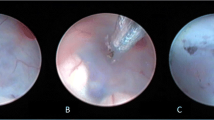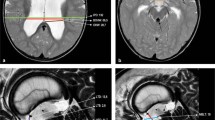Abstract
Purpose
The purpose of this study was to compare outcomes of endoscopic third ventriculostomy (ETV) and ventriculoperitoneal shunt (VPS) in children with symptomatic triventricular hydrocephalus due to primary aqueductal stenosis.
Method
This is a retrospective analytical study. Patients who underwent either ETV or VPS as the first procedure for hydrocephalus due to primary aqueductal stenosis were included in the study.
Result
A total of 89 children were included in the study for analysis. The mean age was 8.4 years. Forty-four (49.4%) had their first surgery as ETV and 45 (50.6%) had their first surgery as VPS. Overall, 34 (38.2%) patients required a second surgery (either ETV or VPS) for persistent or recurrent hydrocephalus. The mean follow-up duration was 832.9 days. The overall complication rate was 13.5%. The mean timing of the second surgery after index surgery was 601.35 days. Factors associated with a second surgery were the presence of complications, high protein in cerebrospinal fluid, the relative change of frontal-occipital horn ratio (FOHR) and Evans’ index. The survival of the first surgery was superior in ETV (751.55 days) compared to VPS (454.49 days), p = 0.013. The relative change of fronto-occipital horn index ratio (FOIR) was high in the VPS (mean 7.28%) group compared to the ETV (mean 4.40%), p = 0.001 group.
Conclusion
Overall procedural survival was better after ETV than VPS for hydrocephalus due to aqueductal stenosis. VPS causes more reduction in linear indices of ventricles as compared to ETV, however, is not associated with the success or complication of the procedure.



Similar content being viewed by others
Availability of data and materials
On request.
References
Tonetti DA, Richter B, Andrews E, Xu C, Emery SP, Greene S (2018) Clinical outcomes of isolated congenital aqueductal stenosis. World Neurosurg 114:e976–e981
Cinalli G, Spennato P, Nastro A, Aliberti F, Trischitta V, Ruggiero C, Mirone G, Cianciulli E (2011) Hydrocephalus in aqueductal stenosis. Childs Nerv Syst : ChNS : Off J Int Soc Pediatr Neurosurg 27:1621–1642
Kulkarni AV, Sgouros S, Constantini S, Investigators I (2016) International Infant Hydrocephalus Study: initial results of a prospective, multicenter comparison of endoscopic third ventriculostomy (ETV) and shunt for infant hydrocephalus. Childs Nerv Syst : ChNS : Off J Int Soc Pediatr Neurosurg 32:1039–1048
Kulkarni AV, Sgouros S, Leitner Y, Constantini S, International Infant Hydrocephalus Study I (2018) International Infant Hydrocephalus Study (IIHS): 5-year health outcome results of a prospective, multicenter comparison of endoscopic third ventriculostomy (ETV) and shunt for infant hydrocephalus. Childs Nerv Syst : ChNS : Off J Int Soc Pediatr Neurosurg 34:2391–2397
Pande A, Lamba N, Mammi M, Gebrehiwet P, Trenary A, Doucette J, Papatheodorou S, Bunevicius A, Smith TR, Mekary RA (2021) Endoscopic third ventriculostomy versus ventriculoperitoneal shunt in pediatric and adult population: a systematic review and meta-analysis. Neurosurg Rev 44:1227–1241
Kulkarni AV, Riva-Cambrin J, Browd SR (2011) Use of the ETV success score to explain the variation in reported endoscopic third ventriculostomy success rates among published case series of childhood hydrocephalus. J Neurosurg Pediatr 7:143–146
Coulter IC, Kulkarni AV, Sgouros S, Constantini S, International Infant Hydrocephalus Study, Constantini S, Sgouros S, Kulkarni AV, Leitner Y, Kestle JR, Cochrane DD, Choux M, Gjerris F, Sherer A, Akalan N, Bilginer B, Navarro R, Vujotic L, Haberl H, Thomale UW, Zuccaro G, Jaimovitch R, Frim D, Loftis L, Swift DM, Robertson B, Gargan L, Bognar L, Novak L, Cseke G, Cama A, Ravegnani GM, Preuss M, Schroeder HW, Fritsch M, Baldauf J, Mandera M, Luszawski J, Skorupka P, Mallucci C, Williams D, Zakrzewski K, Nowoslawska E, Srivastava C, Mahapatra AK, Kumar R, Sahu RN, Melikian AG, Korshunov A, Galstyan A, Suri A, Gupta D, Grotenhuis JA, van Lindert EJ, da Costa Val JA, Di Rocco C, Tamburrini G, Zymberg ST, Cavalheiro S, Jie M, Feng J, Friedman O, Rajmohamed N, Roszkowski M, Barszcz S, Jallo G, Pincus DW, Richter B, Mehdorn HM, Schultka S, de Ribaupierre S, Thompson D, Gatscher S, Wagner W, Koch D, Cipri S, Zaccone C, McDonald P (2020) Cranial and ventricular size following shunting or endoscopic third ventriculostomy (ETV) in infants with aqueductal stenosis: further insights from the International Infant Hydrocephalus Study (IIHS). Childs Nerv Syst : ChNS : Off J Int Soc Pediatr Neurosurg 36:1407–1414
Mandell JG, Kulkarni AV, Warf BC, Schiff SJ (2015) Volumetric brain analysis in neurosurgery: part 2. Brain and CSF volumes discriminate neurocognitive outcomes in hydrocephalus. J Neurosurg Pediatr 15:125–132
Prajapati HP, Ansari MA, Jaiswal M (2022) Comparative outcome analysis of endoscopic third ventriculostomy and ventriculoperitoneal shunt surgery in pediatric hydrocephalus: an experience of a tertiary care center. Asian J Neurosurg 17:227–234
Lu L, Chen H, Weng S, Xu Y (2019) Endoscopic third ventriculostomy versus ventriculoperitoneal shunt in patients with obstructive hydrocephalus: meta-analysis of randomized controlled trials. World neurosurgery 129:334–340
de Ribaupierre S, Rilliet B, Vernet O, Regli L, Villemure JG (2007) Third ventriculostomy vs ventriculoperitoneal shunt in pediatric obstructive hydrocephalus: results from a Swiss series and literature review. Childs Nerv Syst : ChNS : Off J Int Soc Pediatr Neurosurg 23:527–533
Kulkarni AV, Drake JM, Kestle JR, Mallucci CL, Sgouros S, Constantini S, Canadian Pediatric Neurosurgery Study G (2010) Predicting who will benefit from endoscopic third ventriculostomy compared with shunt insertion in childhood hydrocephalus using the ETV success score. J Neurosurg Pediatr 6:310–315
Uche EO, Okorie C, Iloabachie I, Amuta DS, Uche NJ (2018) Endoscopic third ventriculostomy (ETV) and ventriculoperitoneal shunt (VPS) in non-communicating hydrocephalus (NCH): comparison of outcome profiles in Nigerian children. Childs Nerv Syst : ChNS : Off J Int Soc Pediatr Neurosurg 34:1683–1689
Spennato P, Tazi S, Bekaert O, Cinalli G, Decq P (2013) Endoscopic third ventriculostomy for idiopathic aqueductal stenosis. World Neurosurgery 79(S21):e13-20
Texakalidis P, Tora MS, Wetzel JS, Chern JJ (2019) Endoscopic third ventriculostomy versus shunt for pediatric hydrocephalus: a systematic literature review and meta-analysis. Childs Nerv Syst : ChNS : Off J Int Soc Pediatr Neurosurg 35:1283–1293
Dewan MC, Lim J, Gannon SR, Heaner D, Davis MC, Vaughn B, Chern JJ, Rocque BG, Klimo P, Wellons JC, Naftel RP (2018) Comparison of hydrocephalus metrics between infants successfully treated with endoscopic third ventriculostomy with choroid plexus cauterization and those treated with a ventriculoperitoneal shunt: a multicenter matched-cohort analysis. J Neurosurg Pediatr 21:339–345
Nikas DC, Post AF, Choudhri AF, Mazzola CA, Mitchell L, Pediatric Hydrocephalus Systematic R, Evidence-Based Guidelines Task F (2014) Pediatric hydrocephalus: systematic literature review and evidence-based guidelines. Part 10: change in ventricle size as a measurement of effective treatment of hydrocephalus. J Neurosurg Pediatr 14(Suppl 1):77–81
Patra DP, Bir SC, Maiti TK, Kalakoti P, Cuellar H, Guthikonda B, Sun H, Notarianni C, Nanda A (2016) Role of radiological parameters in predicting overall shunt outcome after ventriculoperitoneal shunt insertion in pediatric patients with obstructive hydrocephalus. Neurosurg Focus 41:E4
Warf B, Ondoma S, Kulkarni A, Donnelly R, Ampeire M, Akona J, Kabachelor CR, Mulondo R, Nsubuga BK (2009) Neurocognitive outcome and ventricular volume in children with myelomeningocele treated for hydrocephalus in Uganda. J Neurosurg Pediatr 4:564–570
Riva-Cambrin J, Kestle JR, Holubkov R, Butler J, Kulkarni AV, Drake J, Whitehead WE, Wellons JC 3rd, Shannon CN, Tamber MS, Limbrick DD Jr, Rozzelle C, Browd SR, Simon TD, Hydrocephalus Clinical Research N (2016) Risk factors for shunt malfunction in pediatric hydrocephalus: a multicenter prospective cohort study. J Neurosurg Pediatr 17:382–390
Rodis I, Mahr CV, Fehrenbach MK, Meixensberger J, Merkenschlager A, Bernhard MK, Schob S, Thome U, Wachowiak R, Hirsch FW, Nestler U, Preuss M (2016) Hydrocephalus in aqueductal stenosis—a retrospective outcome analysis and proposal of subtype classification. Childs Nerv Syst : ChNS : Off J Int Soc Pediatr Neurosurg 32:617–627
Author information
Authors and Affiliations
Contributions
SK—analysis and primary draft, one of the operating surgeons in the unit. SS—data collection. DS—study design, analysis, primary draft, one of the operating surgeons in the unit. NS—one of the operating surgeons in the unit. ARP—one of the operating surgeons in the unit.
Corresponding author
Ethics declarations
Ethical approval
According to Indian Council of Medical Research (ICMR), 2017, National Guidelines for Biomedical and Health Research Involving Human Participants, Box no. 52 “Consent Waiver” “retrospective studies where participants are deidentified and cannot be contacted” is mentioned. As our study is mere retrospective case record review, Institute Ethics Committee Review was not done.
Conflict of interest
None.
Additional information
Publisher's Note
Springer Nature remains neutral with regard to jurisdictional claims in published maps and institutional affiliations.
Rights and permissions
Springer Nature or its licensor (e.g. a society or other partner) holds exclusive rights to this article under a publishing agreement with the author(s) or other rightsholder(s); author self-archiving of the accepted manuscript version of this article is solely governed by the terms of such publishing agreement and applicable law.
About this article
Cite this article
Konar, S., Singha, S., Shukla, D. et al. Endoscopic third ventriculostomy (ETV) or ventriculoperitoneal shunt (VPS) for paediatric hydrocephalus due to primary aqueductal stenosis. Childs Nerv Syst 40, 685–693 (2024). https://doi.org/10.1007/s00381-023-06210-w
Received:
Accepted:
Published:
Issue Date:
DOI: https://doi.org/10.1007/s00381-023-06210-w




